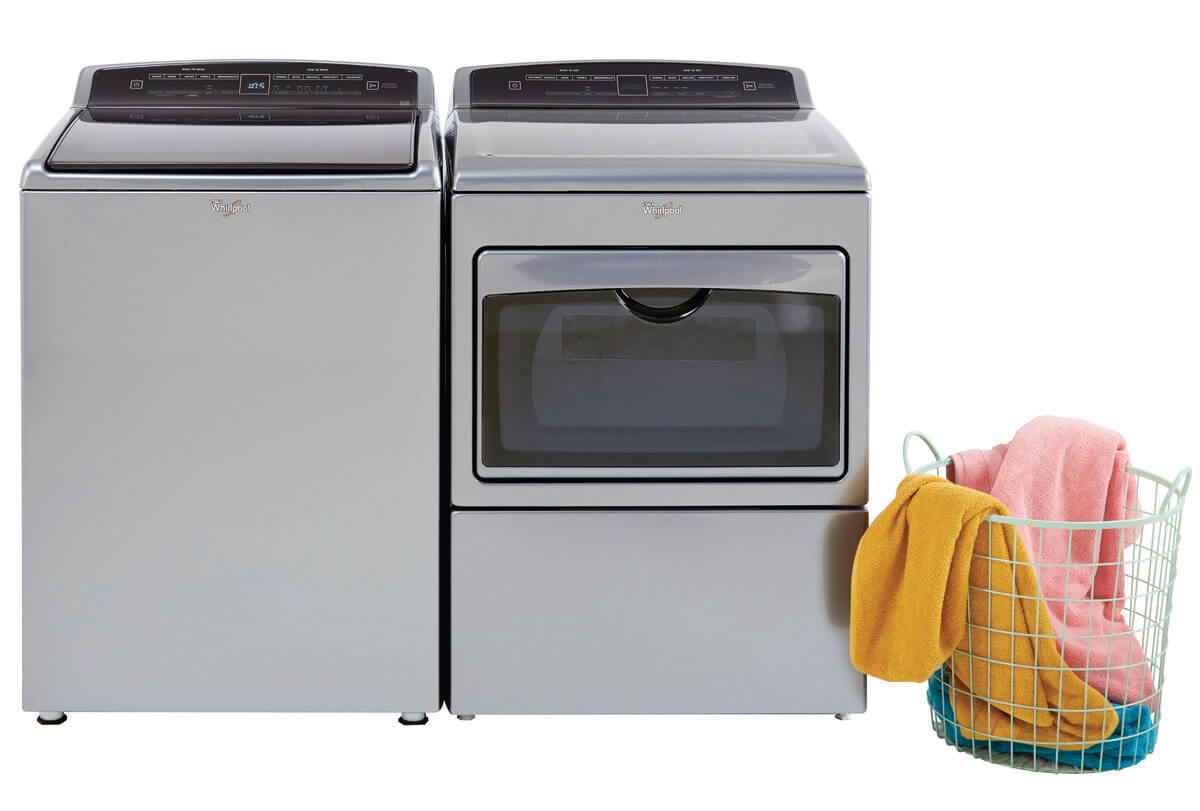
How to Shop for a Washer and Dryer
 The spin cycle on your washer doesn’t work, and your dryer isn’t heating up like it used to. You’re ready to buy a new washer and dryer set, but your head’s spinning from all of the available features and options.
The spin cycle on your washer doesn’t work, and your dryer isn’t heating up like it used to. You’re ready to buy a new washer and dryer set, but your head’s spinning from all of the available features and options.
We’ll walk you through what to look for when buying a washer and dryer — from what features to look for, how to ensure they fit into your space, and some other factors you may not have considered.
Tips for Buying a Washer and Dryer
How do you decide whether to go with a top-load or front-load washer? How do you settle on a gas dryer vs. an electric one? Should you choose an Energy Star Certified machine? And which washer or dryer features would actually benefit your household? Start with Rent-A-Center to answer those questions. Here’s what to consider when buying a washer and dryer.
Step 1: Consider your budget.
Start by establishing a budget for your new washer and dryer. While it’s tempting to go for the latest and greatest models with all the bells and whistles, it’s important to find a balance between your needs and your budget. Remember that a more expensive model may have advanced features but might not necessarily be the best fit for your household and utilities.
However, if you do want to invest in the best features and capabilities for your family, Rent-A-Center’s flexible payment options and free delivery are here to help. After all, your household deserves the latest technology to meet your needs, and it doesn’t have to put a strain on your wallet!
Step 2: Assess the available space and measurements of your laundry area.
Before diving into the world of washing machines and dryers, it’s crucial to consider the available space in your laundry area. Take a moment to measure the space with a tape measure. Doing so will also help determine which washer and dryer sizes are right for your home.
Once you have the measurements, do the following:
- Add an extra inch on both sides of the designated space to ensure enough ventilation for proper air circulation.
- Add six inches of space for hook-ups, vents, and door clearance.
- For front-loading machines, add about four inches in front of the washer and dryer set so you can load and unload clothes.
- For top-loading machines, allow for an extra 20 inches above the appliance, ensuring that cabinets, hooks, or shelves won’t get in the way when loading laundry.
Tip: Note the measurements in your mobile device and bring them when shopping.
Step 3: Consider washer and dryer load capacity.
How many people will be using the washer and dryer? How many loads do you anticipate each week? The answer to these questions will help to determine the right washer and dryer capacity.
The greater the capacity, the more laundry the washer and dryer can hold. For example, standard-size washer drums are 3.5 to 5 cubic feet deep, while high-capacity models can go up to 6.5 cubic feet or more.
As a point of reference, a family of three to four typically requires a washer with 4 cubic feet or more for maximum efficiency. Rent-A-Center features washers with capacities ranging from 1.6 cubic feet to 7 cubic feet.
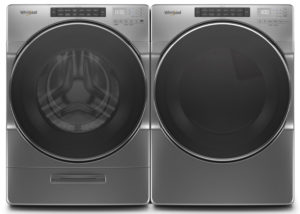 Whirlpool Chrome 4.5 Cu. Ft. Front Load Washer and 7.4 Cu. Ft. Electric Dryer
Whirlpool Chrome 4.5 Cu. Ft. Front Load Washer and 7.4 Cu. Ft. Electric Dryer
Take your laundry from dirty to flirty with all the features this Whirlpool Chrome Washer Dryer Set has to offer:
- XL detergent dispenser to fuel up for several loads at a time
- ENERGY STAR® Certified for efficiency
Rent-to-Own Washers and Dryers >
Step 4: Focus on dryer and washing machine features.
Features impact the way a washer and dryer perform. For example, a fast spin cycle removes excess water and shortens drying time, saving you money on utility bills. (Many of the appliances at Rent-A-Center are Energy Star qualified, which means they’re designed to be energy efficient on laundry day.) Some models have a spin cycle that runs up to 700 rotations per minute.
According to the federal government’s Energy Star program, certified washers use 25% less energy, and about 33% less water than standard models. Certified dryers use about 20% less energy. Many also incorporate advanced features that combine less heat with sensor drying to prevent overdrying.
Otherwise, most dryers use about the same amount of energy. However, you can influence the overall performance with settings such as choice of heat level, timed options, auto dry, and fabric type.
Other features include electronic controls, which enable you to quickly choose cycles, and LED displays. Both of which keep you in the know by showing the remaining cycle time and wash status.
Also, a built-in dispenser offers a timely release of detergent, bleach, and softeners. All that is helpful, but a washing machine with a built-in faucet or soaking area can be a total game-changer! This minor washing machine feature can be a significant addition to your cleaning routine since it allows you to pre-soak extra dirty items like socks and Little League jerseys.
Step 5: Compare different washer types.
At this step in the buying process, you’re practically an appliance expert! Now, it’s time to compare machines side by side. We’ll start with the different types of washing machines.
Top Load Washers vs. Front Load Washers
As their names suggest, a top-load washer opens from the top, and a front-load washer opens from the front. The differences don’t stop there, though. Here are some things to consider when comparing front- and top-load washing machines.
Generally, front-load machines are designed to use less detergent, water, and energy than their top-load counterparts. However, both types of machines are available in high-efficiency (HE) versions.
Depending on your height, a front-load washer can make it easier to put in and take out a load of laundry compared with a top-load machine. If you ever need to add clothes mid-wash, look at top-loaders first. They allow you to pause a cycle, add an item, and pick up where you left off. Front-load machines need to be stopped and drained before any items can be added.
Traditional top-load machines tend to be less expensive than more technologically advanced front-load washers and HE top-load washers—but that’s really only if you’re buying a washer from a typical big box store. At Rent-A-Center, our rent-to-own process means you can get a new washer and dryer without paying full price up-front.
Agitator Washing Machines vs. Impeller Washing Machines
Knowing and understanding the difference between an agitator and impeller washer can help you make an informed decision before moving forward with a purchase. Both types serve the same basic purpose of getting rid of dirt and stains, but they differ in how they do it.
Agitator washers use spindle-like devices in the center of the wash basket to agitate and twist clothes. This technique can be effective at quickly cleaning clothes but may be rough on fabrics and have less space for bulky items.
Impeller washers utilize currents in the water to gently rub clothes against each other, preserving fabric quality, providing more room for large loads, and potentially saving on water and energy costs. However, they may not be as effective at removing deep dirt in their first cycle.
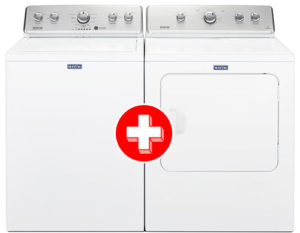 Maytag 4.5 Cu. Ft. Washer + 7.0 Cu. Ft. Gas Dryer Bundle
Maytag 4.5 Cu. Ft. Washer + 7.0 Cu. Ft. Gas Dryer Bundle
This Maytag laundry set can handle everything from stinky sweats to delicate blouses.
- 18 different wash/dry cycle settings for all types of loads
- Time-saving wrinkle control features
Rent-to-Own Washers and Dryers >
Step 6: Compare different dryer types.
As with front-load and top-load washers, there are some significant differences between gas and electric dryers. Here are some things to consider.
First things first: to have a gas dryer, you must have a gas line installed in your home. If you don’t, you’ll need to have one installed or go with an electric dryer (and you can skip step six!).
Some people choose to have gas lines installed because they appreciate the benefits of gas-powered appliances. For instance, gas dryers heat up faster than electric dryers, leading to shorter drying times and sometimes lower utility bills. Generally speaking, natural gas is also less expensive than electricity!
Electric dryers require high-voltage electrical outlets for power. They usually have a three-pronged cable that plugs into a 240 V outlet. While all gas dryers need to be vented to the outside, some electric dryers don’t need to be. So, if you can’t vent your dryer, electric is the way to go.
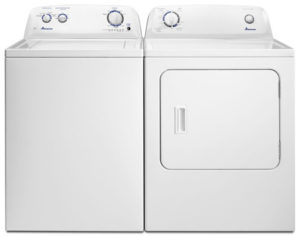 Amana 3.5 Cu. Ft. Top-Load Washer + 6.5 Cu. Ft. Electric Dryer
Amana 3.5 Cu. Ft. Top-Load Washer + 6.5 Cu. Ft. Electric Dryer
This Amana Washer and Dryer Bundle’s advanced features help you get the most out of every load.
- Double Action Agitator for powerful cleaning
- Intermittent drying technology prevents wrinkles
Rent-to-Own Washers and Dryers >
Step 7: Ask Yourself These Questions
We know you have many choices when hunting for a washer and dryer. Here are three final questions to ask yourself when settling on the right set for your home.
1. How big is a full load of laundry at your house? Remember that washer and dryer capacities indicate how much the machines can hold (in cubic feet). Depending on the size of your household’s average laundry load, you may want to select machines with a bigger capacity. Doing high-volume loads less frequently is more energy-efficient than breaking up a lot of laundry into multiple small loads.
2. Does your home have the necessary energy sources? Like we mentioned when comparing gas vs. electric dryers, you may need high-voltage outlets or a gas line connection to power your laundry machines. Ultimately, deciding between gas or electric appliances may come down to what types of utility connections your home already has.
3. How tech-savvy are you? Assuming you’ll be the laundry machines’ top user, consider which features you actually need. A simple washer-dryer set with fewer features will be more user-friendly, while a model with more settings might be harder to use. For most people, temperature and speed controls are good enough—but many benefit from extra settings such as pre-soak, wrinkle control, and bedding. Think about which features you need, and which ones may make you and your family’s laundry time more complicated.
Step 8: Know the top washer and dryer brands on the market.
Rent-A-Center carries three brands of washers and dryers: Whirlpool, Maytag, and Amana. These are three of the most familiar appliance brands in America. They’ve been around a long time. Amana dates back to 1934, while Whirlpool got its start in 1911, and Maytag traces its roots back to 1893.
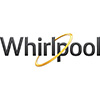 |
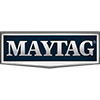 |
 |
|---|
Not sure which appliance brand to choose? Here’s an easy-to-remember trick—Amana offers all the basics, Maytag offers a little more, and Whirlpool has the most bells and whistles! You really can’t go wrong with any of them. And no matter which brand you pick, you can visit your local Rent-A-Center for upgrades, repairs, and replacements.
Step 9: Rent-to-own the best washer and dryer sets at Rent-A-Center.
Renting a washer and dryer can be a great option when you’re in the market for these appliances. Rent-A-Center offers free delivery and setup of washers and dryers. Better yet, with Rent-A-Center’s Worry-Free Guarantee, you get washer and dryer service and repairs at no extra charge over the life of your agreement.
Make laundry day easier. Now that you know what to look for in a washer and dryer, start your order online and stop by your nearest Rent-A-Center location to find the right rent-to-own Maytag, Whirlpool, or Amana options today.